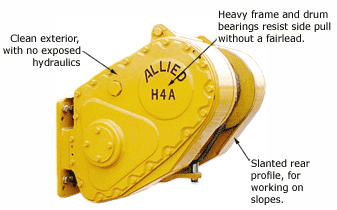
The Allied H4A winch addresses the winch requirements of the new
generation of small hydrostatic dozers. It is designed specifically for
dozer applications, incorporating key features that add maximum value to
the users.
|
|
Hydraulics and hydrostatic technology have made a rapid entry into the world of crawler dozers. Just a few years ago, powershift dozers were the norm. But now more and more hydrostatic dozers are coming into the market, and with them come new challenges for the towing winch.
The key challenge is the PTO shaft, or more correctly the lack of one. Where the PTO shaft was once standard on almost every dozer, many of the new generation machines have no PTO shaft. The classic powershift towing winch, developed at Hyster and continued at Allied, is no longer an option for this type of dozer.
The power take-off is still the simplest and most cost-effective way to drive a winch. However, if the PTO is not available, the solution is a hydraulic winch. But itís a bit more complicated than just strapping an existing hydraulic winch to the back of a dozer and connecting a hydraulic oil supply. Some hydraulic winches arenít designed for dozer applications. And sometimes the hydraulic system canít provide sufficient power. The best choice is engineering a winch specifically for a dozer, not simply adapting a fishing boat winch or crane winch to a dozer.
The first engineering decision is hydraulic supply. The dozerís auxiliary pump, which often operates the ripper, is usually adequate for self-rescue or for occasional use. For production applications such as logging, a higher-flow hydraulic pump is required.
The second key design point is side loading. A dozer winch is frequently subject to side pulls, and the drum bearings and winch housing must be strong enough to handle this rough usage. Some hydraulic winches not originally designed for a dozer, such as a fishing boat winch or crane winch, try to compensate for side loading by dictating the use of a fairlead with the winch. Allied hydraulic winches are designed as true dozer winches, without the requirement for a fairlead. Of course, the fairlead remains an option to help reduce wear on the wire rope and abrasion on the winch case.
|
|
Finally, the winch needs to have a slanted rear profile so that it doesnít strike the ground when climbing steep hills. This issue is typically not considered in developing a fishing boat winch, but is important for dozer applications.
The Allied H4A winch is our first hydrostatic towing winch for the new generation of hydrostatic dozers. With a line pull rating of 40,000 lbs peak line pull, it is the ideal choice for a wide variety of smaller dozers. It has a 2-speed motor that senses the load requirements, to permit high line pull when heavily loaded and fast line speed when lightly loaded. Control is through a single-lever pilot control, which requires only fingertip pressure to operate, and which delivers precise speed control.
One of the great advantages of a hydraulic winch is exceptional control over line speed and line position. This opens up new opportunities such as power line sagging, pulling pipe for re-lining old pipelines and sewer systems, pulling cable through underground conduits, and other work that requires precise control of large loads.
This winch has unusual versatility, which allows it to be used on many different tractor models. Hydraulic supply can come from a dedicated pump, for maximum performance, or it can come from the dozer auxiliary system, for occasional self-rescue.
Standard features include power in, power out, and freespool. Options include 4-roller fairlead, integral log arch, and bolt-on drawbar. A slow-speed gear ratio is available where greater peak line pull is required.
The winch comes with everything required for a complete and professional installation, and itís easy to install in the field. This allows the dealership to mount a winch on a tractor from stock that is not made winch-ready at the factory.
|
Allied H4A Hydrostatic Winch |
|
|
Line pull, bare drum |
31,900 lbs |
|
Line pull, full drum |
18,300 lbs |
|
|
|
|
Line speed, full drum |
207 ft/min |
|
|
|
|
@ wire rope dia. |
5/8 inch |
|
Weight |
1,350 lbs |
|
|
|